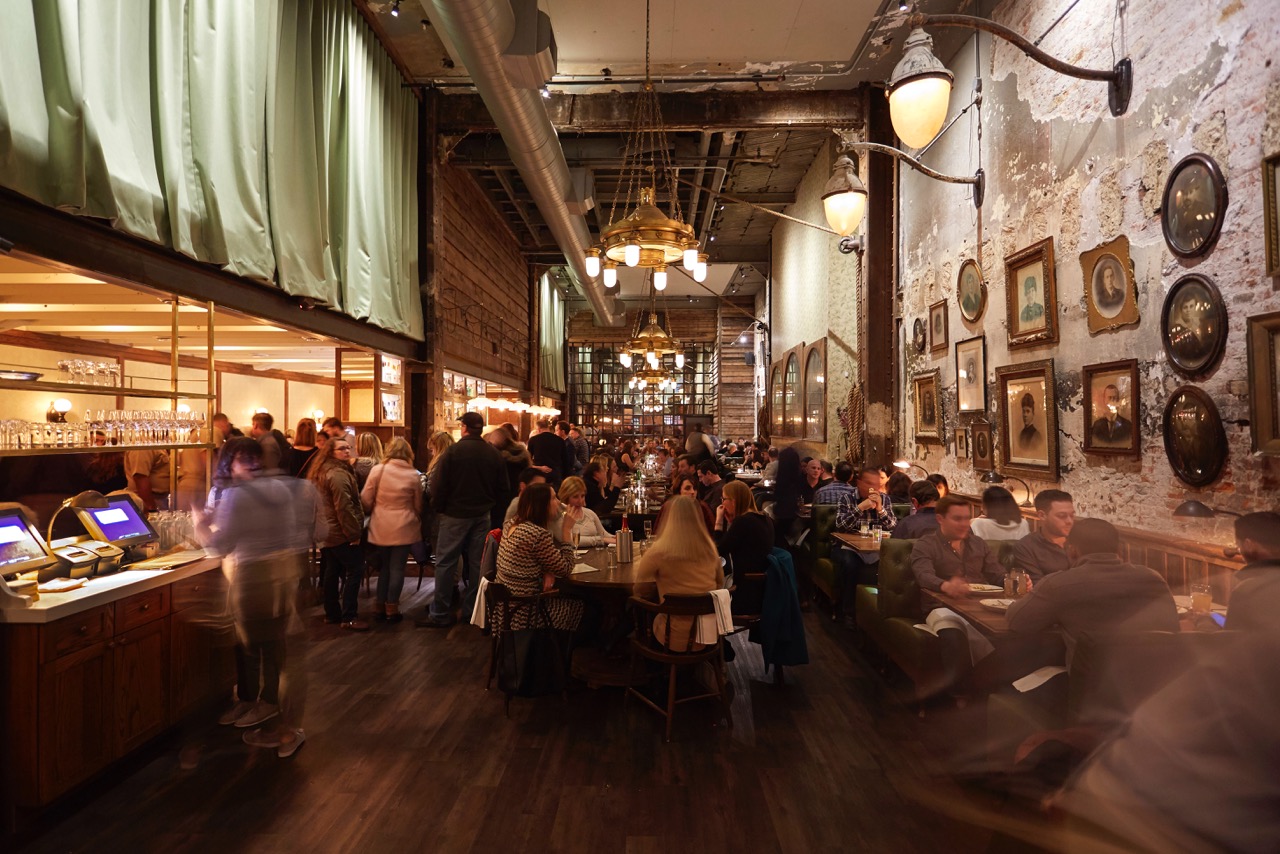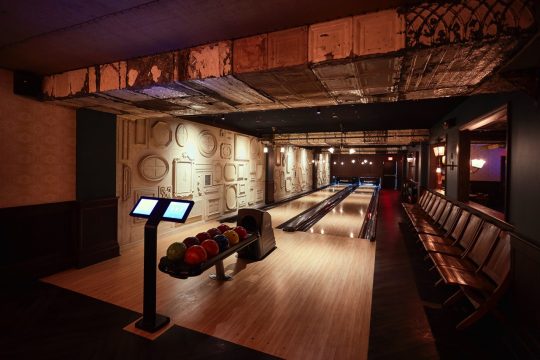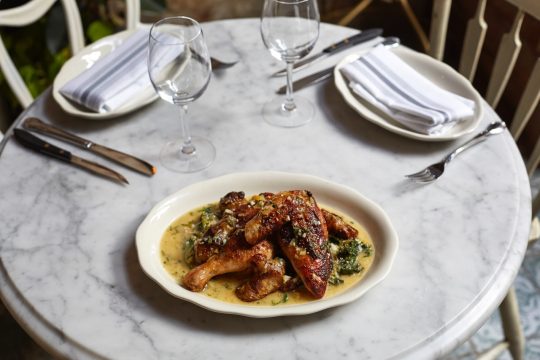The Authenticity Trap: Harp & Crown Reviewed

Photo courtesy Will Figg
On a cold night in December, we threaded our way through the crowds on Sansom Street and found the unobtrusive door. We pushed through the heavy curtains hung to keep the drafts out and stepped into the front room hung with green and living things like a Charleston sunporch, then into the massive, vaulted main space of Harp & Crown, Michael Schulson’s newest experiment in feeding and watering Philadelphia.
Inside, long tables hosted big parties of the city’s hipsterati, laying waste to plates of roasted olives, beef tartare toasts, and leopard-spotted pizzas freighted with unusual ingredients (honey, octopus, shishitos). In cool banquette seats with round swing-arm tables, couples huddled together over cocktails with literary and historic names assembled with the care and inspiration of a grad student’s final thesis. The bar was a free-floating island (an oval of Ouroboros oak, set off from the main room and bathed in yellow light) that hummed with singles and couples drinking beer from a curated bottle-and-draft list and small groups gathered around tables that fell inside its bright corona.
We asked for a booth and were shown to a deep four-top, candlelit, beneath framed antique portraits, pictures of flowers, and one of the huge exposed pulleys through which are threaded thick ropes that hold up the room’s massive chandeliers. Affectless pop music from hidden speakers filled the gaps in conversation. We ordered and drank and ate and paid, and on my way back out through the heavy curtains, as I turned my collar up against the wind, it occurred to me that I hadn’t had a very good time at Harp & Crown. That somehow this very carefully calculated experience, stage-managed at every step, had passed around me and through me like air, without leaving a mark. I had eaten a meal and felt (almost) nothing about it, save fuller. In ways I couldn’t really understand, being inside the machinery of Harp & Crown felt colder than being outside.
And it was the second time this had happened.
There are two very obvious reasons why I might have felt this way. First, Schulson also opened Double Knot last year, where I had some of my best meals of 2016. It was a restaurant I didn’t expect to love but fell for with whiplash swiftness, and came to respect for its smart business model and its risky concept (a basement fusion restaurant in a former porno theater that wore a combination coffee shop/restaurant/happy-hour bar like a very stylish hat). There was virtually no way Schulson could have topped himself with a second space that in many ways followed that same blueprint: He made a big space look gorgeous, then burrowed into an underground location for a subterranean bar (and bowling alley) that’s not secret, exactly, but still feels exclusive.

Photo courtesy Will Figg
Second, because in doing that—in copying so closely what made Double Knot great—Harp & Crown can’t help but feel like a copy. It can’t help but feel faded and, I don’t know … inauthentic by comparison. But inauthentic is a slippery word to throw around. No big restaurant attempting to straddle that middle ground of American appetite is ever going to be “authentic” by any rational definition of the word. You know what’s authentic? Guy Fieri’s Times Square restaurant. That thing is exactly what it’s meant to be. Double Knot borrowed a kind of authenticity in sticking tight to what felt like the vision of its creator—it was cool because it didn’t try to be anything but the best version of itself.
But Harp & Crown feels like a restaurant designed by committee. Or designed with demographics, trend graphs and traffic flow studies in the foreground. And the more I thought about it, the more it fell apart for me. Those little round tables at the banquette seats? They’re more pretty than functional—no good for holding anything more than two drinks and one small plate. The cocktail list, in retrospect, felt less like that metaphorical grad student having a flash-of-brilliance conclusion than it did a grad student meticulously arranging his footnotes—bourbon here, gin there, bitters, botanicals and fruit, all in their proper place.
Notice how I haven’t really mentioned the food yet? That’s because there’s so little to say. Because we could play a game where I did nothing but tell you about the space and the concept and the location and then had you blindly guess what was on the menu, and you’d get half of it right. The menu, coming from a kitchen run by chef Karen Nicolas (ex of Citron + Rose, Tria and elsewhere), is precisely what you expect of Philly at this moment—pizzas that aren’t quite as good as the pizzas at Wm. Mulherin’s, salumi and cheese, burrata that came too milky and was paired with pickled figs and a caper pesto, lamb meatballs soaking in red sauce and served in their own adorable cast-iron pan.

Photo courtesy Will Figg
The grilled prawns came with delicious thick slices of pickled tomato, but the plating was discordant—too fancy and deliberate for the space or the menu or the attempted vibe. The faro spaghetti with spinach pesto and ricotta was like eating a brick—so heavy and gluey that one bite seemed to weigh a pound. The roasted chicken was excellent—the skin crisp and almost shellacked, the meat perfectly cooked and juicy. The bird itself was the best I’ve had since the nearly perfect chicken I ate at La Peg. But the kitchen paired it with roasted sunchoke that tasted like gooey water chestnut and tennis ball rubber, and escarole that tasted of absolutely nothing, which was just cruel. The halibut, served with crabmeat and chickpeas in a delicate, steaming fennel broth, was the one dish that stuck with me. And then I heard it was coming off the menu soon, and I just wanted to light something on fire.
Above all else, though, the worst sin Harp & Crown commits is dullness. With the possible exception of that halibut (RIP) and the Dying Declaration (a bourbon and cinnamon tincture cocktail that tastes like what a grown-up version of Fireball could be), there was nothing there that made me want to go back. Elbow Lane, the downstairs bar, is a cozy little nook in which to curl up with a couple friends, but it gets weird when it’s busy (loud and almost claustrophobic) and weirder when it’s quiet (because it feels like a buried tomb). I bowled a round in the two-alley side room before the place officially opened to the public and enjoyed myself, but I can’t imagine just strolling in on a Tuesday for a game and a beer and a burger.
Ultimately, what Schulson created with Harp & Crown is a very approachable, very beautiful, very large gastropub, but nothing more than that. It’s a convenience restaurant, you know? The place you go when you don’t really want to think about where to go. If you’re in the neighborhood, it’s a perfectly reasonable spot for some food and a couple of drinks. If you’re rolling with a big crowd, they can accommodate you. But if you’re looking for greatness, you might just want to keep walking.
2 Stars — Come if you’re in the neighborhood
Harp & Crown [f8b8z]


